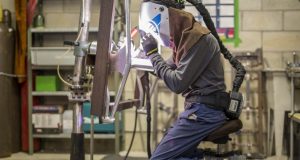
S.K. Gupta, Technical Director, Jupiter Wagons and Jupiter Alloys & Steel India Ltd.
Director Quivan Skills Empowerment Pvt. Ltd.
INTRODUCTION
The word Ergonomics has several meanings. The first is literal. Derived from two Greek words: Ergo = work; and Nomos = laws. Therefore, ergonomics literally means the laws of work. But the practical meaning of Ergonomics is fitting the task and work environment to the human physical limitations. Ergonomists try to design tasks and workplaces to suit the capability of the human. In most of our workplaces layout design and selection of production processes there are many tasks, work environments, and even products, which do not take human capabilities into consideration.
Ergonomics is the science of designing and arranging plant, machinery, equipment and positioning of job for efficient and effective workout by operators. It is also named as Human Factors Engineering. It is the science and relationship interaction between worker and workplace environment. Ergonomics attempts to make the workplace comfortable to the operators to work with minimum fatigue of body and limbs. Ergonomics focuses on designing Process and Method to suit worker capabilities and not changing worker. It does not try to make workers adjust to the workplace. When a workplace is designed properly, the worker feels comfortable. Quality and production increase. Everyone benefits.
OBJECTIVES OF ERGONOMICS
- Reduce injuries and disorders
- Ensure worker Safety
- Ensure worker Health
- Reduce Absenteeism
- Ensure worker Productivity
PROBLEMS FROM POOR ERGONOMICS
- Musculoskeletal Disorders (MSD)
- Repetitive Motion Injury
- Worker Dissatisfaction
- Increased Absenteeism
- Increased Turnover rates
CAUSES OF THE PROBLEMS
- Reaching
- Bending
- Heavy Lifting
- Using continuous Force
- Working with Vibrating Equipment
- Repetitive Motions
- Awkward Postures
- Temperature
SYMPTOMS OF MSDS
- Less Gripping strength
- Less Range of Motion
- Loss of Muscle function
- Painful Joints
- Pain, Numbness in body Limbs
- Shooting or Stabbing Pains
- Swelling or Inflammation
- Stiffness or Burning sensation
Ergonomics includes many different scientific disciplines such as: physiology, biomechanics, psychology, anthropometry, industrial hygiene and kinesiology.
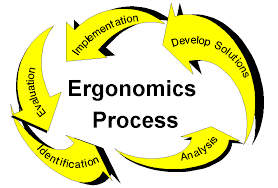
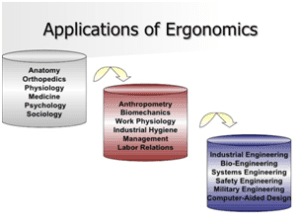
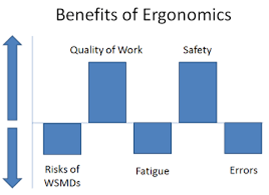

MUSCULOSKELETAL DISORDERS (MSD)
Discomfort and pain are common in human-work activities. Workers working in the industrial sector are prone to be exposed to such risk of discomfort and pain resulting injuries. Occupational risk factors are the most common entity to cause health problems. Exposure to occupational hazards adversely affect the functioning of human body and in turn reduce worker productivity and product/work quality and increase musculoskeletal problems.
MSDs, or musculoskeletal disorders, are injuries and disorders of the soft tissues of the human body (muscles, tendons, ligaments, joints, and cartilage) including the nerves and tendon sheaths, and most frequently involve the arms and back. Occupational safety and health professionals have called these disorders in variety names such as:
- Cumulative trauma disorders
- Repeated trauma
- Repetitive stress injuries
- Occupational overexertion syndrome.
These are painful, and often occur as disabling injuries. Such injuries generally develop gradually over a period of weeks, months and years. MSDs usually result from exposure to multiple risk factors that can cause or accelerate the disorders. MSDs are not caused from a single event or trauma such as a fall, collision, or entanglement. Frequently, workers lose time from work to recover; some never regain full health. MSDs can cause a number of conditions, including pain, numbness, tingling, stiff joints, difficulty moving, muscle loss, and sometimes paralysis .These disorders include:
- Carpal tunnel syndrome
- Tendinitis
- Sciatica
- Herniated discs
- Low back pains
Work Related Musculoskeletal Disorders
Work situations and conditions that are likely to cause MSD problems include the following:
- Exerting excessive force more than normal;
- Continuous and excessive repetition of movements that can irritate tendons and increase pressure on nerves;
- Forced awkward postures, or unsupported positions that stretch physical limits, can compress nerves and irritate tendons;
- Static postures, or positions that a worker must hold for long periods of time, can restrict blood flow and damage muscles;
- Abrupt motion, such as increased speed or acceleration when bending and twisting, can increase the amount of force exerted on the body;
- Compressive forces from grasping sharp edges like tool handles, can concentrate force on small areas of the body, reduce blood flow and nerve transmission, and damage tendons and tendon sheaths;
- Inadequate recovery time for tissue repair due to overtime, lack of breaks, and failure to vary tasks.
- Continuous and excessive vibration, usually from vibrating tools, can decrease blood flow, damage nerves, and contribute to muscle fatigue.
- Vibration of the whole-body such as from driving trucks or operating subways, or continuous chipping can affect skeletal muscles and cause low-back pain; and
- Working in extreme hot or cold temperatures can adversely affect a worker’s coordination and manual dexterity and cause a worker to use more force than necessary to perform a task.
These risk factors, either alone or in combination, can cause thousands of repetitive twisting, forceful, or flexing motions to the muscles, tendons, cartilages of the shoulders, arms, hands, wrists, backs, and legs of workers during a typical working day. When present for a sufficient duration, frequency, or magnitude MSDs will result from these risk factors.
Additionally, environmental conditions such as working in extreme temperatures may contribute to the quick development of WMSDs. Personal risk factors, such as physical conditioning, preexisting health problems, gender, age, work technique, hobbies and organizational factors (e.g., job autonomy, quotas, deadlines) may also contribute to, but do not cause, development of WMSDs.
The Nature of Welding
Welding is a versatile manufacturing process in metal fabrication industry and plays a vital role to produce almost all the Engineering products. Welding is estimated to contribute to almost 50% of the nation’s gross national product.
Welding often requires awkward body positions continued over a long period of time thereby causing high prevalence of musculoskeletal complaints and injuries including back injuries, shoulder pain, tendonitis, and reduced muscle strength. On this context, there is lot of scope for improvement in the operating (welding) postures which in turn will help to reduce discomfort and pain, thereby increasing productivity, worker safety and quality of work in welding-industry. Problems are actually in the mismatches between man and machine, improper layout design, unhealthy work environment and mainly ignorance among top to bottom.
Most of the tasks welders perform are dictated by the design of the item being worked. In almost all cases welding in the field requires the welder to adapt to the workplace, rather than adapting the workplace to the welder. This is because in many cases, the materials are big, heavy, and might be covered with dirt, rust, and/or grime and it is easier to have the welder assume an awkward posture, than move the Job. Welding also is hot work and generates harmful metal fumes.
The use of proven ergonomic principles can improve the way a particular task is performed, thereby reducing welder exposure to risk factors. This generally translates to a healthier workforce, improved morale, greater productivity and increased product quality.
Common WMSDs for welders include:
- Back Injuries – From strains and sprains to degradation of the vertebral disks.
- Bursitis – Inflammation of a saclike bodily cavity, containing a viscous lubricating fluid located between a tendon and a bone or at points of friction between moving structures (i.e. inflammation of a bursa).
- Carpal Tunnel Syndrome – A complex disorder that starts with the inflammation of the tendon sheaths in the wrist and progresses into the degradation of median nerve
- Tendonitis – Inflammation of the tendons.
- Tenosynovitis – Inflammation of tendon sheath.
- Thoracic Outlet Syndrome – A disorder in which blood vessels and nerves in the upper shoulder region are compressed and cause pain. This condition is sometimes caused by chronic postures associated with overhead work.
- Trigger Finger – Tendons in the fingers ‘lock down’ due to injury to the tendons.


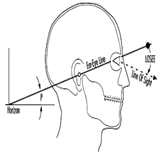
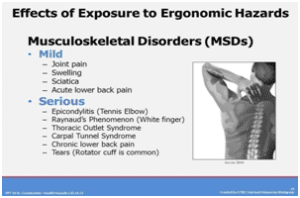

Consider lower back vertebral disk degeneration. The vertebral disk is made of flexible cartilage and contains a semi-liquid gel. The cartilage is in the form of rings. When a person performs lifts beyond their capability, these rings can degrade. If the person continues performing such lifts the disk can rupture. When it ruptures it bulges out and can place pressure on a spinal nerve causing severe pain.
Ergonomics Stressors Compression: Leaning on a hard surface
Awkward & Static Posture: Holding the arms away from the body for long durations

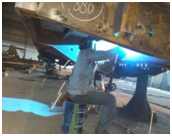
Welding with the hands in front of the body
Ergonomics Stressors: Awkward & Static Posture: Extension of the neck, static loading in the arms and shoulders.

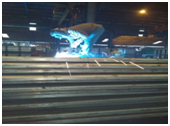
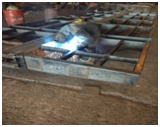

Welding at ground level
Ergonomics Stressors: Awkward & Static Posture: Extension of the neck, static loading in the arms and shoulders


Welding above shoulder height
Ergonomics Stressors: Awkward & Static Posture: Hot work in a static posture caused by the constrained space Compression: Leaning on a hard surface

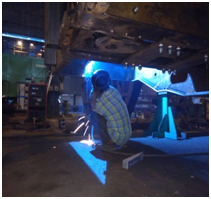
Welding in constrained spaces
Ergonomics Stressors: Awkward & Static Posture: Working with the back bent forward and wrist in extension Compression: Leaning on a hard, sharp surface
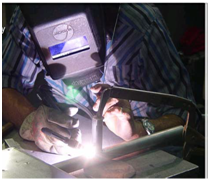
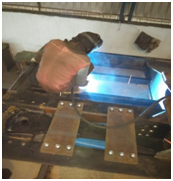
Welding with back bent forward
Ergonomics Stressors: Awkward & Static Posture: Working with the back bent


Working with the back bent forward
Ergonomics Stressors: Awkward & Static Posture: Statically Holding a stooped
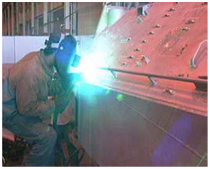

Working in a stooped posture
Ergonomics Stressors: Awkward & Static Posture: Working with the back bent forward and holding the arms away from the body Compression: Resting the arms on a hard surfaces


Working with the back bent forward
Ergonomics Stressors: Awkward & Static Posture
A few of the following photographs show various awkward and strained body postures during welding which invariably cause ergonomic stresses.

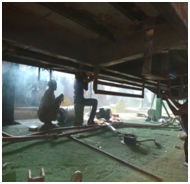


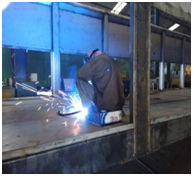
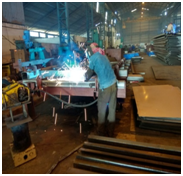

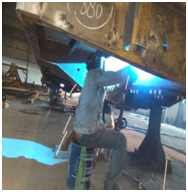
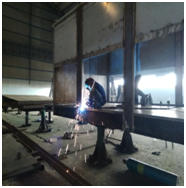
Such welding postures can be avoided by improvements in Jigs, Fixtures and Positional welding. This is absolutely essential where manufacturing /production of welded parts , components and sub assemblies are conducted day in and day out for weeks, months and sometimes in years together.
ERGONOMIC SOLUTION APPROACH
Ergonomic solutions for welders describe changes to equipment, work practices and procedures (administrative controls) that can address ergonomics-related risk factors, help control costs, and reduce employee turnover.
These changes will also increase employee productivity and efficiency because they eliminate unnecessary movements and reduce heavy manual work.
However, there are numerous job aids such as fixtures, jigs, and part holders available to aid welders in doing their jobs and reduce the risk of injury. In addition, special chairs and/or creepers are available that provide body support while performing tasks so that an awkward posture is avoided.
Action Plan for Implementing Solutions to Reduce Workplace Risk Factors;
Step 1: Look for clues
- Observe work activities
- Risk factors
- Worker fatigue
- Tool / equipment modifications
- Increased absenteeism
- Decreased production
- Bottlenecks / missed deadlines
- Talk to workers (form ergonomics action teams or designate an ergonomic point of contact)
- Use assessment tools
- Risk factor physical check list.
Step 2: Prioritize job for improvement: Consider
- Frequency & severity of the risk factors
- Frequency & severity of complaints
- Injuries
- Workers’ ideas
- Timeframe for making improvements
- Difficulty in making improvements
Step 3: Make improvements – Improve the fit between task demands & worker capabilities
- Talk to various employees
- Contact other industries
- Consult ergonomics experts
- Use internet resources
Step 4: Follow-up:
- Has each improvement reduced or eliminated the risk factors, fatigue, discomfort symptoms or injury reporting?
- Has each improvement been accepted by the workers?
- Have any improvements created new risks or other problems?
- Have any improvements impacted production or quality?
- Are implemented improvements supported by training?
Use suggested PRACTICAL SOLUTIONS of the work for acceptable Ergonomic Postures as shown in the photographs below.




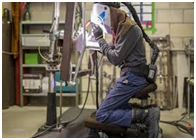




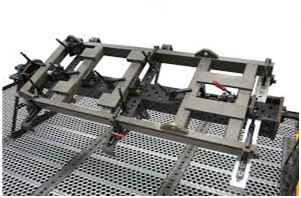

BETTER POSTURES WITH FIXTURES AND POSITIONERS
ERGONOMICALLY ACCEPTED POSTURES DURING WELDING
POSSIBLE SOLUTIONS TO PROBLEMS
- Recognize that often Repetitive Motion Injury is mistakenly felt to be a type of short-term weakness or fatigue. Actually it is the start of potentially more serious injuries.
- Address complaints in a timely manner.
- Get employee input.
- Interact with the worker. Discuss possible solutions. Give the employee ownership of any new plans. Promote employee acceptance of solutions.
- Redesign the workstation with the employees’ help. Employees should feel part of the process.
- Utilize gravity when it can help move material to the work area or station. This helps to prevent unnecessary material handling.
PRACTICAL SOLUTIONS—HOW TO AVOID THE HAZARDS
- Avoid fixed work positions. They reduce the blood supply to muscles.
- Keep elbows close to the body.
- Avoid positions where arms are raised above shoulder level.
- Use lighter hand tools.
- Suspend tools.
- Support your elbows.
- Provide sufficient rest.
- Utilize jigs and fixtures.
WORKSTATION DESIGN FACTORS
Some factors to consider:
- Position of the work.
- Physical ability of the worker.
- Design and weight of the tools.
- Body mechanics of the operation.
- Type of protective equipment used.
- Workspace / environment (size, lighting, temperature, noise, vibration, etc.).
- Physical requirements of the job (lifting, turning, reaching, etc,).
- Mental requirements (motivation, alertness, concentration).
- Strength and size of the workers.
CONCLUSION
In India, small, medium and large scale industries using welding as Manufacturing Process must understand and appreciate the fact that “Welding Is A Special Process” and Welders are human beings with specially trained skills carrying out the said process. In order to aim for higher productivity and better quality we must nurture the well being of the welders for maintaining and improving the skills.



